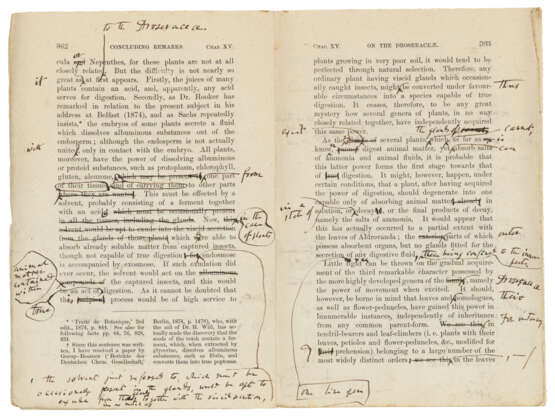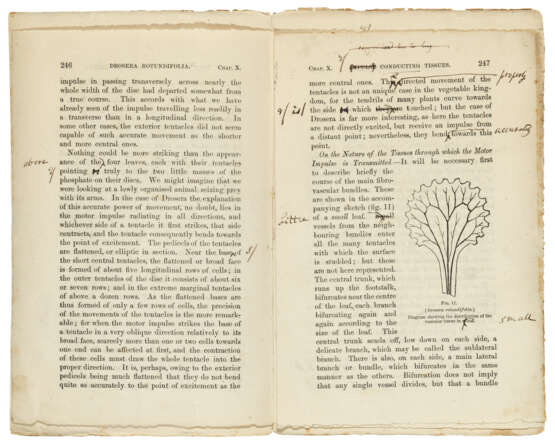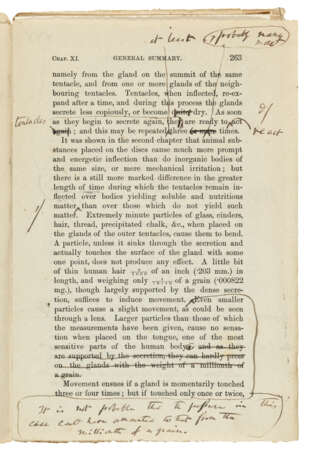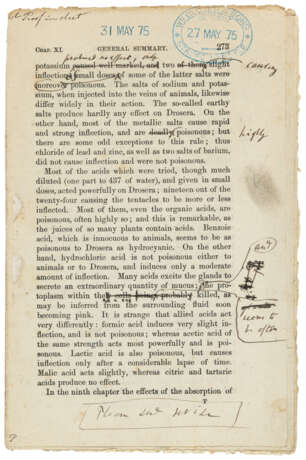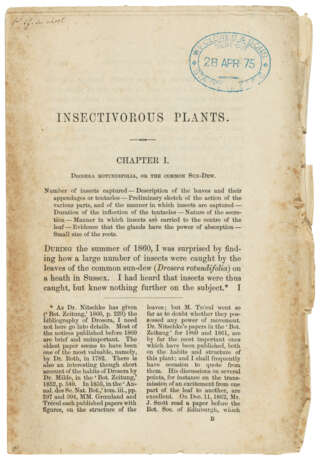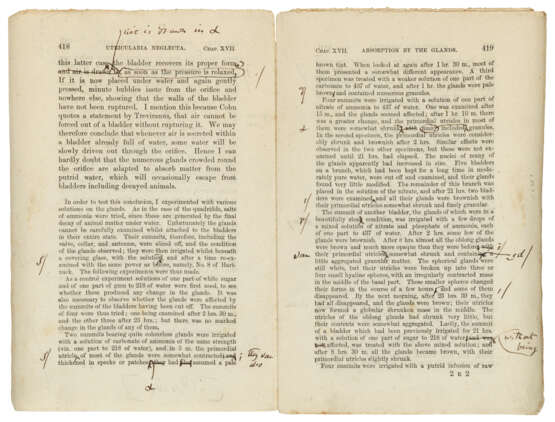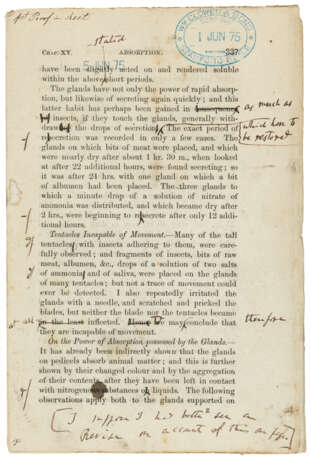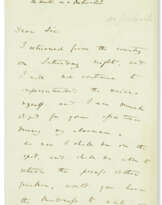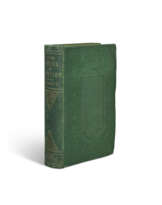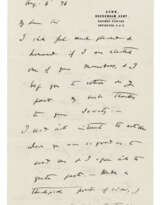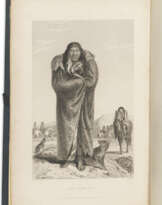ID 993158
Lot 82 | DARWIN, Charles (1809-1882)
Valeur estimée
£ 150 000 – 200 000
Revised proof sheets for Insectivorous Plants. London: W. Clowes and Son for John Murray, 1875, with substantial autograph annotations, emendations and cancellations.
Darwin’s corrected proof sheets for Insectivorous Plants, showing substantial revisions in his own hand. One of Darwin’s final published works, Insectivorous Plants was a study of the adaptations of such organisms and represented a continuation of his enquiries into the process of evolution. Unpublished and hitherto unrecorded by Darwin Online, the appearance of these annotated proofs at public auction allows for the first time a reconstruction of Darwin’s revision of the text in preparation for publication.
Octavo in 8s, 190 x 125mm, iii + 219 + i leaves, loose in gatherings, three paginated leaves, 28 signatures (lacking signature ‘O’ and with 2G4-7, the Index, present here in galley proof form, printed on one side of a single sheet and folded), each signature annotated ‘1st Proof in sheet’ and ‘P’ by the printer and stamped with the date on which it was sent to Darwin (28 April-4 June 1875), over 1,300 words, emendations or cancellations in Darwin’s hand between signatures R-2G [with, laid in:] autograph note headed ‘To the compositor’ regarding the layout of p.265 following Darwin’s text changes, on a slip of paper (114 x 181mm) inserted between pp.264-5 [and:] the corresponding seven lines of corrected text in another hand, on a slip of blue paper (109 x 209mm). Modern green morocco case, gilt lettered, by Atelier Laurenchet. Provenance: Jonathan Hill, bookseller, catalogue 54, 1990, no 21 – to the present owner.
After many years spent labouring on human evolution, sexual selection, and the expression of emotions, by 1873 Darwin was able to devote his attention to his beloved plants. Botanical observation and experiment had long been his greatest scientific pleasure and he devotedly maintained a variety of small investigations across the writing years, telling Emma Darwin that these served as his best form of relaxation. Further ambitions in experimental botany were side-tracked well into the 1870s, which saw the publication of The Descent of Man and The Expression of the Emotions. With these monumental projects complete, and selling well, Darwin could finally resume his study of the digestive powers of sun-dews and Venus fly-traps, and the comparative fertility and vigour of self- and cross-pollinated species, work that would culminate in two books: Insectivorous Plants (1875) and Cross and self fertilisation (1876). In the former, Darwin investigated the function and significance of carnivorous habits in certain species of plant, discovering that their ability to trap and digest insects was an adaptation enabling them to survive even in extremely poor soil.
Having first written of his enthusiasm for the common sun-dew, Drosera rotundifolia, in a letter to Charles Lyell in 1860, Darwin returned to his experiments many years later with unabated enthusiasm; as the project gathered momentum across 1873 and 1874, he enlisted the help of Joseph Dalton Hooker, Asa Gray, and an army of scientific correspondents to send further specimens to Down or to conduct their own experiments in parallel. ‘I have hardly ever enjoyed a day more in my life than this day’s work’, he wrote to the aristocratic horticulturalist Dorothy Nevill in September 1874, thanking her for a specimen of carnivorous bladderwort supplied from her well-stocked garden (DCP-LETT-9644). His investigations drew upon methodology from a variety of scientific fields, including physiology and chemistry, and offered Darwin the opportunity to work in the way he loved best: combining careful observational practice with theoretical insight. They also reflected a new focus on adaptation, which informed the revised edition of Descent in 1874, a second edition of Variation in 1875, and the amended sixth edition of the Origin: ‘in these revised books Darwin eased in to a more adaptationist frame of mind, suggesting that there was a role in evolutionary theory for the inheritance of some acquired characteristics […] Although he had never categorically excluded behaviourally or environmentally induced adaptations from his writing, he now felt that they should play a larger part’ (Browne, p.407).
In January 1875, after nine months of writing, Darwin was ready to send the manuscript of Insectivorous Plants to John Murray: the pleasure of experimentation had mostly given way to continuous writing and revision, though, inevitably, he kept finding new things to observe. He wrote in some despair to Hooker in February: ‘I thought it was decently written, but find so much wants rewriting, that it will not be ready to go to Printers for 2 months & will then make a confoundedly big book’ (DCP-LETT-9850). A first set of proofs were returned to Darwin from the printers on 18 April 1875; a letter to his German translator J.V. Carus written the following day records their receipt, with Darwin adding that his manuscript has grown so large that Murray will now publish a second ‘little book’ on climbing plants in the autumn (DCP-LETT-9940). The present proofs, in sheets, bear the stamp of the printer, William Clowes & Sons, on the first page of each gathering, marking their dispatch in successive parts to Darwin between 28 April and 4 June; Darwin records the receipt of two sets of proofs in a letter to John Murray on 29 April (DCP-LETT-9955), presumably the first gatherings of our set and of another – incomplete – set at Cambridge University Library (CUL-DAR213.5, comprising pp.97-256, stamped 11 and 25 May). Signatures A-Q in our proofs bear no revisions in Darwin’s hand, raising the possibility that the earlier set for Insectivorous Plants, sent on 18 April, were returned with his corrections to the first half of the book before 28 April or, perhaps, that the missing pages from the Cambridge proofs contained these revisions (the extant pages at Cambridge contain only two annotations in Darwin's hand). On 17 June 1875, Darwin sent clean sheets for half of the book to Carus with a promise that the remaining sheets would be sent within two weeks: ‘The latter half is, I think, more interesting than the first half, as rather more diversified & not so much in detail’ (DCP-LETT-10021). After substantial revisions to the book in May and into June – Emma Darwin records her husband furiously at work on the proofs at this time – Insectivorous Plants was finally ready for John Murray to publish on 2 July 1875. Darwin’s fears that such a technical book would unlikely make a second edition proved unfounded: 1,700 copies sold straight away; a second and third thousand copies were printed off quickly, with a forth thousand following in 1876.
While the existence of these proof sheets has been known from Darwin’s correspondence, their whereabouts have remained unknown to scholars and the extent of the substantial autograph revisions unrecorded by the Darwin Project Online. Their presentation at public auction allows for the first time a reconstruction of Darwin’s revision of the text in preparation for publication. Cambridge University Library holds autograph manuscript drafts and notes for Insectivorous Plants (alongside the near-clean set of proofs in sheet referred to above, with pp. 241-453 of the ‘1st Revise in sheet’); further single leaves are in institutional collections – including the British Library, the Smithsonian, Christ’s College, Cambridge, and the State Library of Denmark – but just one has appeared at auction in the past twenty years.
References:
Janet Browne, Charles Darwin: vol. 2 The Power of Place, 2002, pp.407-412.
Darwin Correspondence Project:
https://www.darwinproject.ac.uk/letters/darwins-works-letters/insectivorous-plants
https://www.darwinproject.ac.uk/letters/darwins-life-letters/darwins-letters-1873-animal-or-vegetable
https://www.darwinproject.ac.uk/letters/darwins-life-letters/darwin-letters-1874-turbulent-year
https://www.darwinproject.ac.uk/letters/darwins-life-letters/darwin-letters-1875-pulling-strings
Special notice
This lot has been imported from outside of the UK for sale and placed under the Temporary Admission regime. Import VAT is payable at 5% on the hammer price. VAT at 20% will be added to the buyer’s premium but will not be shown separately on our invoice.
| Artiste: | Charles Robert Darwin (1809 - 1882) |
|---|---|
| Lieu d'origine: | Europe du Nord, Europe, Royaume-Uni |
| Catégorie maison de vente aux enchères: | Lettres, documents et manuscrits |
| Artiste: | Charles Robert Darwin (1809 - 1882) |
|---|---|
| Lieu d'origine: | Europe du Nord, Europe, Royaume-Uni |
| Catégorie maison de vente aux enchères: | Lettres, documents et manuscrits |
| Adresse de l'enchère |
CHRISTIE'S 8 King Street, St. James's SW1Y 6QT London Royaume-Uni | |
|---|---|---|
| Aperçu |
| |
| Téléphone | +44 (0)20 7839 9060 | |
| Commission | see on Website | |
| Conditions d'utilisation | Conditions d'utilisation |
